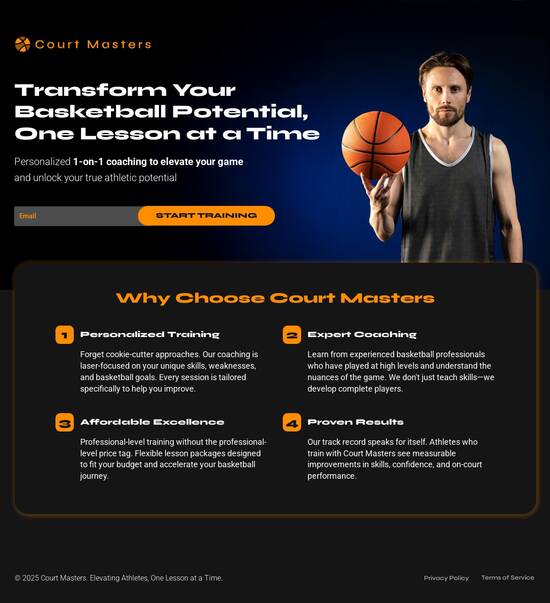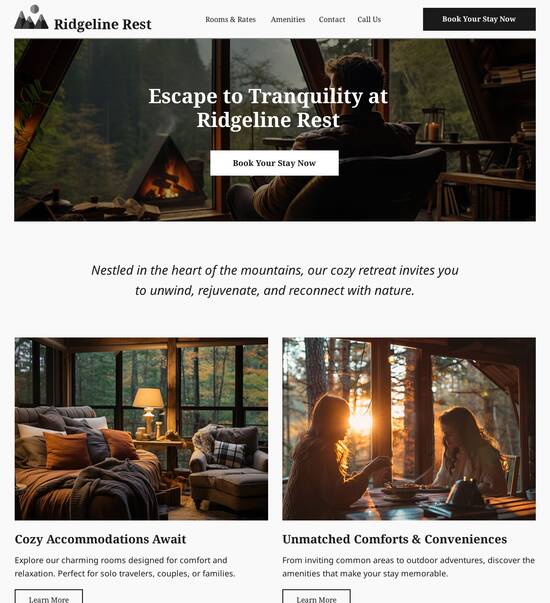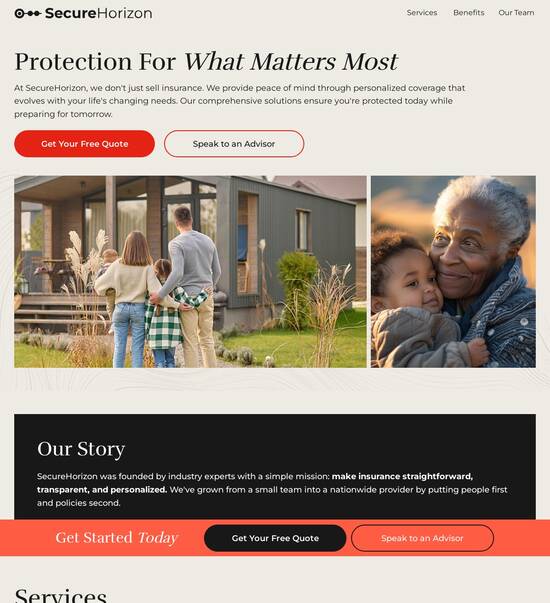
HTML page template for self driving car companies
Use TemplateAbout template
Give your self driving car companies a boost with our professional landing page templates. Ready to turn visitors into customers?
Recommended templates

Easy to build without coding
With the intuitive drag-and-drop builder, anyone on your team can create high-converting pages without any knowledge of code or design. Make enhancements to your landing page with custom widgets using Javascript, HTML/CSS, or third-party scripts.

Multiple layouts for any industry and goal
Select from 500+ landing page layouts built to boost conversions across industry-specific scenarios. Customize them by adjusting fonts, adding images, and generating on-brand content with the AI assistant. Quickly scale with Instablocks® and Global Blocks that you can save, reuse, and update globally.

Loads fast and looks polished on any device
Every template is responsive, which means they present professionally on any device and load blazingly fast with our Thor Render Engine. You can also power them up with Google AMP technology to deliver an unparalleled mobile experience and drive higher conversions.

Robust analytics & experimentation
Get real-time updates and reporting across all your devices, showing the number of visitors, conversions, cost-per-visitor, and cost-per-lead. Launch AI-powered experiments, run A/B tests, and use heatmaps to analyze user behavior, then optimize your landing page to maximize conversions.







Easy to build without coding
With the intuitive drag-and-drop builder, anyone on your team can create high-converting pages without any knowledge of code or design. Make enhancements to your landing page with custom widgets using Javascript, HTML/CSS, or third-party scripts.
Multiple layouts for any industry and goal
Select from 500+ landing page layouts built to boost conversions across industry-specific scenarios. Customize them by adjusting fonts, adding images, and generating on-brand content with the AI assistant. Quickly scale with Instablocks® and Global Blocks that you can save, reuse, and update globally.
Loads fast and looks polished on any device
Every template is responsive, which means they present professionally on any device and load blazingly fast with our Thor Render Engine.
Robust analytics & experimentation
Get real-time updates and reporting across all your devices, showing the number of visitors, conversions, cost-per-visitor, and cost-per-lead. Launch AI-powered experiments, run A/B tests, and use heatmaps to analyze user behavior, then optimize your landing page to maximize conversions.
All the features you need to build lead-generating landing pages
Explore more featuresLearn how to build top-performing landing pages for any goal
FAQs
Leading the way in building high-performing landing pages





Unlock the potential of Instapage for effective landing page creation
Instapage stands as the leading landing page and conversion rate optimization (CRO) platform designed for marketers aiming to excel in their digital campaigns. With its expansive toolset, you can efficiently convert prospects into customers, regardless of your marketing budget or team size. The platform is particularly beneficial across various industries, including business services, education, and tech.
Understanding the significance of landing pages
Landing pages play a crucial role in directing potential customers towards your goals. With Instapage, you gain access to over 100 conversion-focused templates that streamline the creation process. These ready-to-use templates are not just visually appealing but are also optimized for conversions, ensuring you capture leads effectively.
- Pre-built templates cater to different industries, ensuring relevance.
- Customization options allow for personalized branding, enhancing recognition.
- Quick edits and adjustments to templates save time and increase campaign agility.
Step 1: Create compelling landing pages
Begin your journey by utilizing Instapage's easy-to-use page creation tools. The platform's library of conversion-focused layouts and Instablocks allows you to design pages without any coding knowledge.
Step 2: Optimize for maximum performance
Once your landing page is live, it's essential to leverage built-in optimization tools.
- Use A/B testing to gauge the effectiveness of different elements.
- Analyze on-page behavior with heatmaps to enhance user interactions.
- Monitor performance metrics through the analytics dashboard to make data-driven decisions.
Step 3: Personalize for your audience
Customization goes beyond just aesthetics. Personalization ensures your content resonates with individual audience segments.
- Dynamic text replacement enhances relevance for varied visitor groups.
- AdMaps help align specific advertisements with the corresponding landing pages.
- Data tracking capabilities allow you to assess engagement on an audience level.
With Instapage, you not only create landing pages but also establish an ecosystem that nurtures conversions through continual optimization and personalization.
Ready to amplify your marketing efforts? Explore how Instapage can help you create landing pages that convert!
HTML Page Template for Self-Driving Car Companies: An In-Depth Exploration
Understanding the landscape of self-driving car companies
The self-driving car industry is experiencing rapid growth, capturing the attention of both consumers and investors. As the technology evolves, companies are racing to position themselves as leaders in the autonomous vehicle market. The market potential is vast, with projections indicating that the self-driving car sector could be worth hundreds of billions of dollars within the next decade.
Having a robust digital presence is crucial for companies involved in automotive innovation. An effective website is not only a platform for disseminating information but also plays a vital role in branding, marketing, and engagement. As self-driving technology advances, a well-designed HTML page template can help companies showcase their innovations and communicate with their audience effectively.
Defining the core functionality of an HTML page template
Streamlined structure for seamless user navigation, ensuring visitors can easily find information about self-driving technologies.
Responsive design for diverse device compatibility, guaranteeing a consistent experience across desktops, tablets, and smartphones.
Integration capabilities with API for real-time data updates, enabling companies to present dynamic information on their sites.
The role of a browser: Rendering the template
Browser compatibility is fundamental when creating HTML page templates. Since web users have a preference for various browsers, ensuring your template functions well across multiple platforms is essential. Each browser has distinct rendering quirks, which can greatly impact user experience. Therefore, developers should prioritize compatibility with major browsers such as Chrome, Firefox, Safari, and Edge.
An optimal user experience is heavily influenced by how well these browsers interpret HTML, CSS, and JavaScript. The reliability of your template in different browsers can mean the difference between a smooth, engaging interaction and a frustrating user experience. Ensuring cross-browser functionality should be a key focus when designing templates for self-driving car companies.
Enhancing user experience with iolazy loading
Iolazy loading is a technology that delays the loading of images and other resources until they are about to enter the viewport. This is especially beneficial for image-rich content often featured on websites dedicated to self-driving cars. By implementing iolazy loading, companies can significantly enhance loading speeds, reducing bounce rates and improving user retention.
Incorporating iolazy loading into an HTML page template can be as simple as using JavaScript libraries or native browser features. When effectively employed, it ensures that visitors do not have to wait long for content to appear, allowing for an engaging and seamless browsing experience. Tips for implementation include lazy loading only critical assets and testing performance across various devices to ensure optimal results.
Utilizing video backgrounds: Captivating the audience
Video backgrounds have emerged as a powerful tool for self-driving car companies to convey their innovative spirit and technological prowess. By utilizing engaging video content, brands can tell compelling stories that resonate with their audience, creating a lasting impression. It is essential to optimize these videos to prevent distractions, ensuring they enhance rather than detract from the site's message.
Embedding video content in an HTML template typically involves using the tag and setting appropriate attributes for autoplay, loop, and mute. Best practices include ensuring that videos are lightweight and have a fallback image for users on limited bandwidth. Performance metrics should also be evaluated, such as load times and user engagement rates, to gauge the effectiveness of video backgrounds.
Color schemes: Reflections of brand identity
Color psychology plays a significant role in branding, especially for tech companies in the self-driving car industry. The right color scheme can inspire trust, innovation, and excitement, which are traits that are particularly important in this sector. Companies may opt for sleek, modern palettes encompassing blues and metallics to reflect technology and reliability.
When designing HTML templates, it’s crucial to choose colors that not only match the company’s vision but also harmonize well. Tools like Adobe Color and Coolors can assist in creating viable color palettes. Customization options should be available in the template to allow companies to ensure their branding shines through consistently across different pages.
Navigating website template builders for customized experiences
Website template builders have become indispensable tools for self-driving car companies looking to establish an effective online presence quickly and efficiently. These platforms allow users to create customized experiences without requiring advanced technical knowledge, making it easy for marketers to execute their vision. Features like drag-and-drop editing, customization options, and built-in analytics elevate usability and mark the need for template builders in the modern marketing landscape.
When deciding between templates and custom builds, it’s essential to weigh the pros and cons. Templates often offer speed and cost-effectiveness, while custom builds provide unique functionality tailored specifically to business needs. A step-by-step approach to using template builders should include selecting a base template, making design customizations, and optimizing for SEO and user engagement.
Selecting the right fonts: Crafting brand voice and legibility
Typography plays a crucial role in any web design, particularly in communicating a brand's narrative. Selecting fonts that are both legible and reflective of the brand's voice is essential for self-driving car companies. For example, modern sans-serif fonts can convey cleanliness and innovation, while serif fonts may suggest tradition and reliability.
A collection of font styles that resonate well within the tech industry can include Roboto, Open Sans, and Lato. Combining font styles harmoniously involves choosing complementary typefaces for headings and body text that enhance readability and user experience. Always ensure that the chosen fonts are web-safe and accessible to create a consistent and appealing visual identity.
Designing headers that command attention
Headers are often the first point of interaction between a user and a website. Crafting headers that command attention requires a clear structure that encapsulates essential information. Effective headers should be informative yet engaging, prompting visitors to explore further. The use of impactful language, contrasting colors, and visually engaging graphics can all contribute to an effective header design.
Elements to consider in header design include size, placement, and interactivity. For instance, sticky headers that remain visible during scrolling can enhance usability. Furthermore, existing landing pages that have innovative header designs can serve as inspiration, showcasing how headers can effectively encapsulate brands and enhance user engagement.
Utilizing columns for efficient content organization
Column layouts offer a practical way to organize content visually, enhancing readability and comprehension. In the self-driving car sector, where information may be dense, having a well-structured layout becomes paramount. Achieving a balance between images and text within column designs can guide users’ focus and comprehension, allowing them to digest information at their own pace.
When designing responsive columns, it’s essential to consider how they will adapt across various devices. The use of CSS grid systems can provide greater control over how contents are arranged. Best practices include ensuring that column widths are flexible and that content is not compressed, thus maintaining clarity regardless of screen size.
The art of layout: Structuring for maximum impact
Layout is a vital aspect of web design, particularly for websites focused on innovation like those of self-driving car companies. Key layout designs can significantly enhance user interaction and engagement through intuitive navigation and visual appeal. For example, a grid layout may work best for showcasing multiple products or concepts, while a single-column layout might be better for storytelling.
Additionally, certain layouts are more suited for specific types of content, such as infographics, videos, or customer testimonials. Utilizing tools such as CSS frameworks can facilitate the creation of custom layouts, allowing for flexibility in design while adhering to best practices in user experience.
Incorporating essential design elements
Design elements such as buttons, icons, and callouts often underpin the overall functionality and aesthetics of an HTML template. Each of these elements contributes to guiding users through the content and should be designed with both form and function in mind. A consistent visual aesthetic across all design elements fosters brand identity and user familiarity, making navigation more intuitive.
Guidelines for maintaining consistency involve using a uniform color scheme, size, and style for buttons and icons across the website. Additionally, special attention should be paid to ensuring that callouts for important information stand out without overwhelming the user, allowing for a clean yet engaging design that aligns with the brand’s values.
Crafting compelling content: The backbone of engagement
Compelling content is critical in engaging audiences, particularly in tech-driven sectors like self-driving cars. Techniques for writing persuasive and informative content should focus on clarity, relevance, and storytelling. Content that educates while fostering emotional connections can be particularly powerful in the realm of ground-breaking automotive technologies.
The format of content can take many forms, including text-based articles, infographics, and interactive media. It’s important to consider the unique challenges associated with each format, such as how best to convey complex technology in easily digestible terms. A cohesive content strategy should ensure that all formats align with the overall brand messaging and objectives.
Imagery that speaks volumes: The visual approach
Visuals play a significant role in enhancing user engagement and aiding in information retention. In the world of self-driving cars, high-quality images and videos can showcase technology, safety features, or real-world applications. Having access to a library of striking visuals can elevate a brand’s narrative, making its technology more accessible to diverse audiences.
When sourcing imagery, it’s critical to select high-quality visuals that align with brand identity. Legal considerations must also be taken into account, especially regarding copyright and licensing. Companies should consider using resources like stock photo websites or partnering with photographers to ensure all imagery is legally compliant and resonates with their audience.
Footers: The unsung hero of navigation
The footer, often overlooked, plays a crucial role in website navigation. A well-structured footer can enhance user experience by providing essential information and links without cluttering the main content. Key elements to include in an effective footer are contact information, social media links, and quick navigation options to other sections of the site.
Innovative footer designs can include features like a mini sitemap or an email subscription form, enhancing user interaction. As self-driving car companies aim to establish trust and credibility, ensuring that the footer is both functional and visually appealing can foster a professional online presence.
The significance of DOMContentLoaded
Understanding the DOMContentLoaded event is essential for optimizing web performance. This event fires when the initial HTML document has been completely loaded and parsed, significantly impacting user experience. Minimizing the time to this event ensures that users can interact with the site more quickly, reducing frustration and improving engagement.
Best practices to improve loading times include minifying code and optimizing images. By ensuring that scripts don’t block rendering and that important content is prioritized, self-driving car companies can create a smoother, more enjoyable user experience online.
Identifying and solving common HTML template problems
HTML templates can present various challenges, from responsiveness issues to poorly structured code. Identifying common pitfalls such as unresponsive elements or misaligned content layouts is crucial for ensuring usability. Strategically addressing these issues with clear coding practices will result in a more functional and aesthetically pleasing website.
Resources for troubleshooting template usage can include community forums, documentation, and coding tools that help identify issues quickly. A proactive approach will save time and enhance the overall effectiveness of the self-driving car company’s online presence.
The utility of a download panel: Streamlining access
Incorporating a download panel within an HTML template can streamline access to vital resources, such as brochures, manuals, and whitepapers. These downloadable resources can provide users with in-depth information on self-driving technologies and innovations, enhancing their understanding and engagement with the brand.
Strategically placing download calls-to-action within the template will encourage users to interact more deeply with the content. By promoting these resources effectively, self-driving car companies can increase user participation and brand loyalty.
Future trends: Evolving HTML templates for the autonomous vehicle market
As technology advances, the needs of self-driving car companies will continue to evolve, prompting a shift in HTML template designs. Future trends may focus on adaptability, with templates that can respond to rapidly changing information and user interactions. Companies will benefit from designing templates that can easily incorporate advanced technologies such as AI-driven personalization and real-time data feeds.
Staying ahead of these trends will require consistent evaluation and updates to ensure that designs remain modern and effective. By anticipating user needs and market shifts, self-driving car companies can ensure that their website presence continues to align with advancements in technology and consumer expectations.
Ready to skyrocket conversions?
Supercharge your ad campaigns with high-performing landing pages
Get started














